- AUSCHWITZ AND SURROUNDINGS
(31-32) Auschwitz and Birkenau lay in upper Silesia at the junction of the Weichsel and the Sola rivers in the vicinity of Cracow. This zone was selected by the German as the location of numerous industries (30), because it was rich in coal, which was indispensable for the production of synthetic benzene, synthetic rubber and other substitute products. Many major German companies had branches here. The field was moreover out of range for Allied bombers at the beginning of the war and possessed good transport connections.
The I.G. Farben industrial complex was located between Auschwitz and Monowitz. The prison camp located here also referred to as Auschwitz III. Birkenau was often referred to as Auschwitz II. Auschwitz was the main camp on the banks of the Sola.
(32) The Auschwitz I main camp (in the middle) was formerly a Polish barracks. Birkenau ( Auschwitz II), was in contrast, hastily built in record time. It was originally planned fir the use of approximately 100,000 Russian prisoners of war. There was still no talk of a deportation of the Jews at this time. The Buna complex lay between Auschwitz and Birkenau.

(30) Air photo of the Buna works.
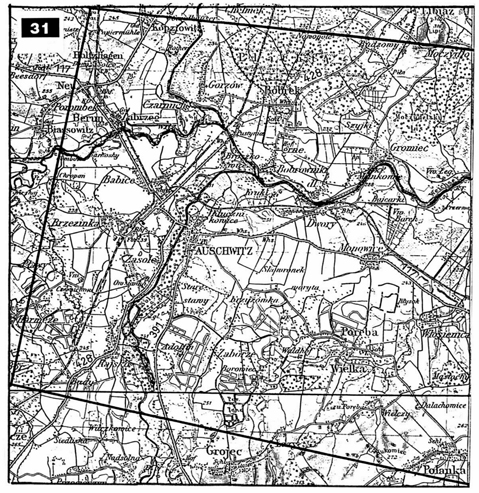
map
FIRST DOCUMENT
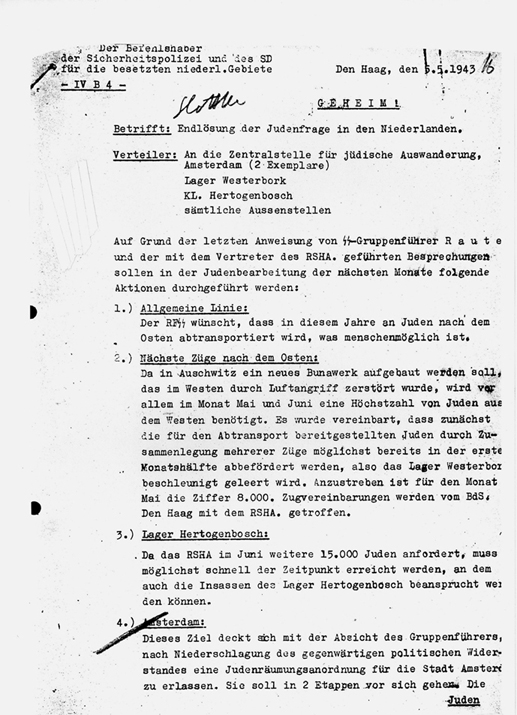
(33) Document relating to the deportation of Jews. Note the word “Endlösung”, which, as may be seen from the context, has no relation whatsoever to any liquidation of the Jews. The second paragraph describes the true function of Auschwitz camp, it was a gigantic industrial complex (30), which needed tens of thousands of workers. Another document contains an order stating that deportations to the East may only be carrier out if the train also carries the necessary living barracks. This makes a mockery of the claim that the purpose of the deportations was “mass extermination”
.
TRANSLATION OF DOCUMENT SHOWN ABOVE
The commandant of the Security Police and SD for the occupied territory of the Netherlands, den Haag 05.05.1943.
Regarding: Final solution of the Jewish question in the Netherlands Distribution list, tot the Central Office for Jewish emigration, Amsterdam Camp Westerbork.
Based on the latest instructions from SS Gruppenführer Raute and consultations with the representative of the RSHA (Reich Security Main Office), the following actions are to be carried out in the processing of Jews over the next few months, General guideline. The RF SS wishes to transport as many Jews to the East this years as possible. Next trains to the East, Since a new Buna plant is to be built at Auschwitz, which would not be destroyed by air attacks in the West, a very great number of Jews will be needed from the West, above all, in the months of Amy and June. It was agreed that first, the Jews ready for deportation should be transport through the coupling together of several trains during the first half of the month, that is, that the Westerbork camp should be rapidly emptied. Attempts should be made to attain the figure of 8,000 for the month of May. Train arrangements are being made by the BdS, Den Haag, with the RSHA. Since the RSHA is demanding another 15,000 Jews for June, the time must be reached as quickly as possible, when it will be possible to make use of the inmates of the Hertogenbosch camp as well. Amsterdam: This objective is compatible with the intent of the Gruppenführer to issue an order to empty the city of Amsterdam of Jews after defeating the present political opposition. This is take place in 2 stages. The Jews…
SECOND DOCUMENT
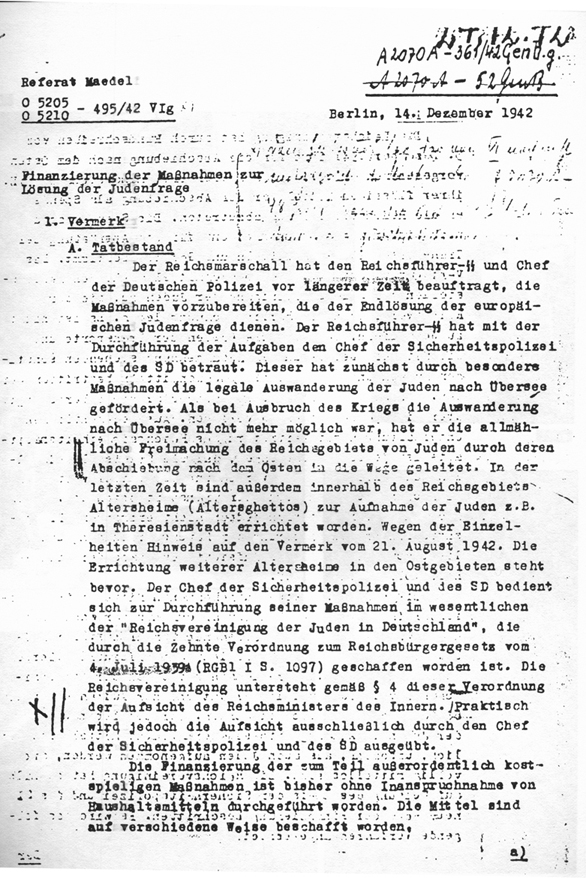
TRANSLATION OF DOCUMENT SHOWN ABOVE
[references]
Berlin, 14 December 1942
[references]
Financing of the Solution to the Jewish Question
1. Comment
A. State of the Situation
The Reichmarschall has assigned the Reichsführer SS and Chief of the German Police with preparation of the measures for the Jewish Questions over an extended period. The Reichsführer SS has entrusted the Chief of the Security Police and SD with implementation of these tasks. He first encouraged the legal emigration of the Jews overseas through special measures. When emigration overseas was made impossible by the outbreak of the war, he introduced the gradual freeing of the Reichsterritory from Jews through their deportation to the East. Moreover, old people’s homes (ghettos for the aged) for the reception of the Jews were recently built within the Reichs territory, for example, at Theresienstadt. For details, please see remark of 21 December 1942. The construction of further old people’s homes in the Eastern territories is planned for the near future. The Chief of the Security Police and SD, for the implementation of their measures, have largely used the ‘Reichs Association of the Jews German’, which was created by the Tenth Order of the Reichs Citizenship Law of 4 July 1939. The Reichs Association, according the section 4 of this regulation, is subject to supervision by the Chief of the Security Police and SD. The financing of the measures, some of which are extraordinarily expensive, has thus far taken place without making any budgetary claims. The funds are being raised in various ways...
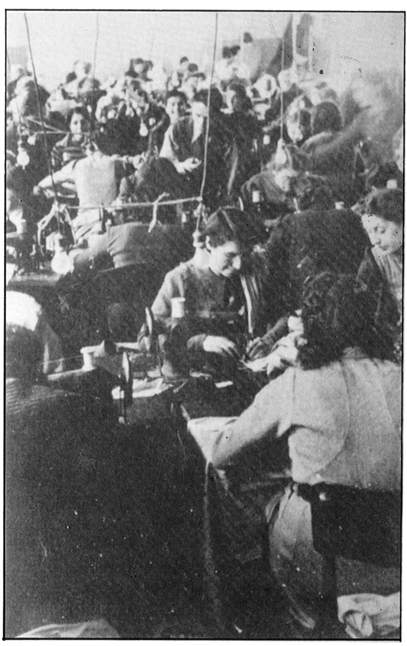
(32bis – 35) Germany wished, first of all, to win the war, and needed all available lab our. Photos of workshops in the Jewish ghetto of Lodz.
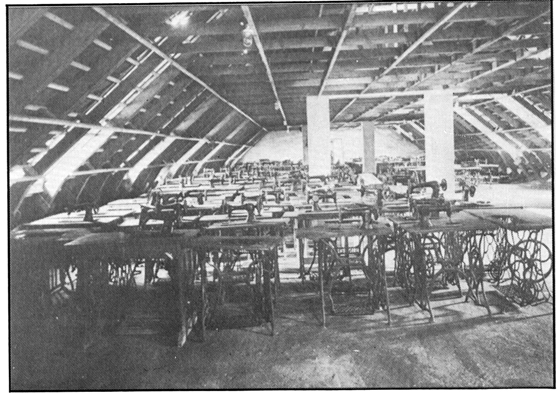
(36) Garment workshop at Auschwitz. Jean-Claude Pressac claims that these sewing machines were brought along with them by women deportees. The innumerable photographs of the deportation show not one single woman carrying a sewing machine on her back. Pressac’s interpretation is a perfect example of groundless and deliberate misinterpretation.
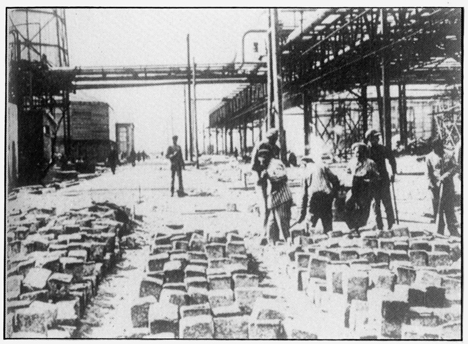
(37) Inmates were mostly assigned to general work such as building roads and irrigation installations, or to the support of civilian (Polish and German) workers.
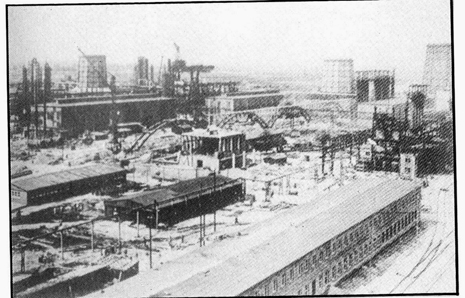
(38) Factory for the manufacture of synthetic materials.
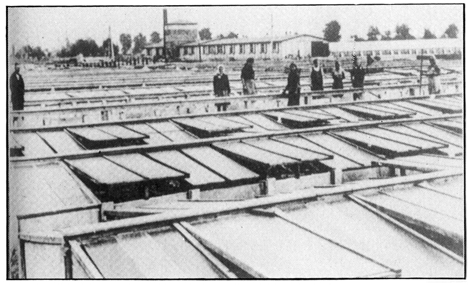
(39) Horticulture
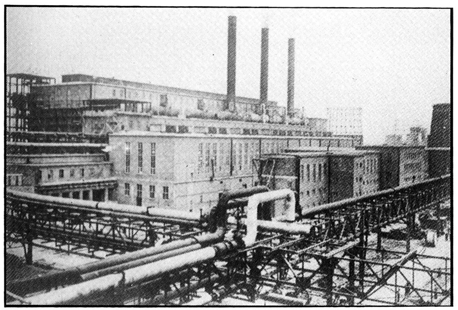
(40) The I.G. Farben power plant at Monowitz.
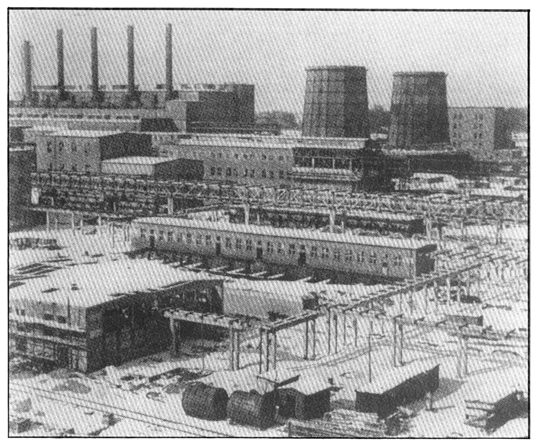
(41) The enormous Buna works manufacturing complex at Auschwitz III.
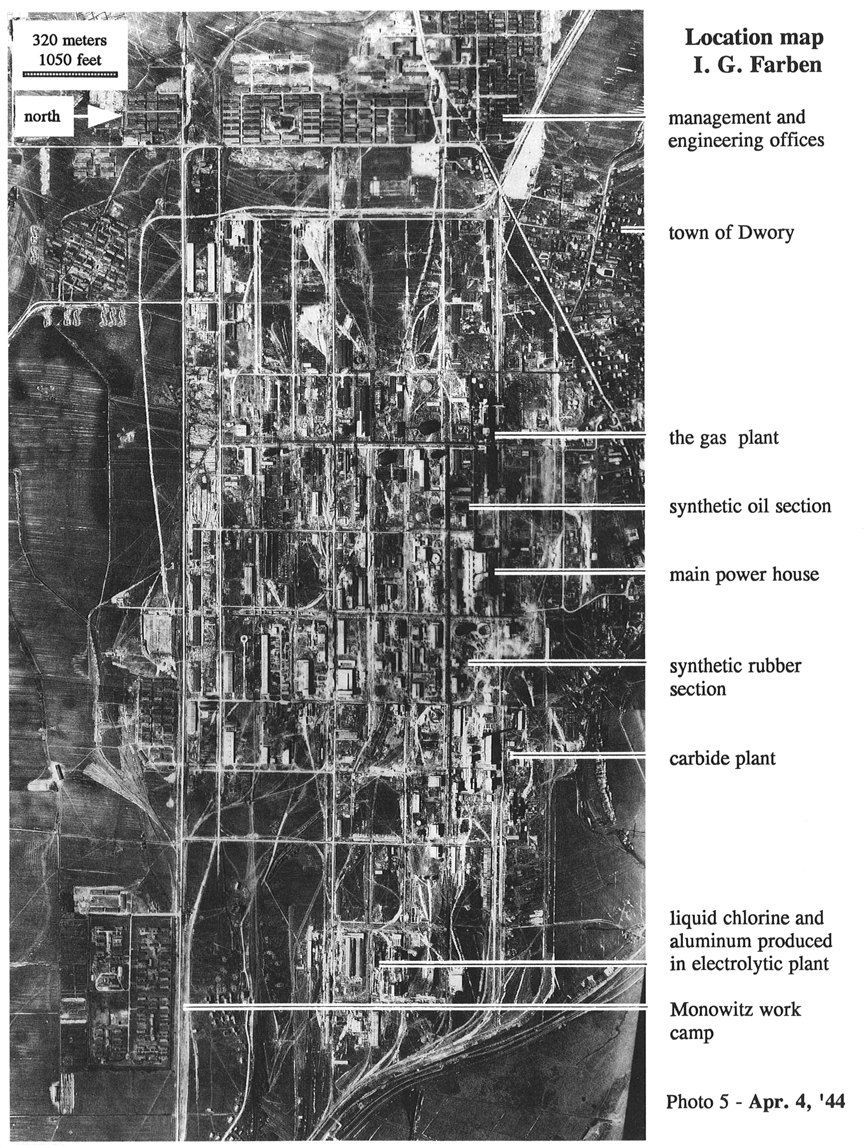
(42) Air photo of I.G. Farben, 4 April 1944.
I.G. Farben built a complete new production plant a Auschwitz, where a variety of synthetic products were manufactured from coal, especially benzene, rubber and oil.
If the Germans had wished to kill the Jews with gas, inexhaustible quantities of numerous other, more efficient and cheaper chemical products were available for the purpose. Grotesquely, they are supposed to have selected a product manufactured in a factory near Berlin, a product which was in short supply and always expensive and in no way suited to the quick, efficient gassing of human beings, as we will see below.
Zyklon B was in such short supply that the factory could not even fill the required production quotas assigned them by the Wehrmacht. ZyklonB was a vermin control agent urgently needed on all fronts to prevent or controls epidemics.
In addition to I.G. Farben, approximately 30 other manufacturing plants had built subsidiaries at Auschwitz, including Krupp. There was an electrical plant, miles and miles of streets and roads, in addition to farmhouses and fields to feed the hundreds of civilians workers as well as inmates.
GERMAN DOCUMENTS
[missing document graphic - somebody goofed -- dont' worry, we'll find it]
Regarding: conversion of ZyklonB circulation gas chambers to ‘Arginal’ and report on the number of gas chambers.
Relating to: Communication of the Supreme Health Officer dated 15.05.1944, journal number 308/44.
To the Supreme Health Officer
c/o Reichs doctor SS and Police
Berlin, Zehlendorff
Spanish Alee 10
With regards to the above mentioned communication, it is stated that there are 10 hydrocyanic acid circulation gas chambers in operation at Buchenwald concentration camp, with a cubic capacity of 10cbm each.
SIGNATURE
SS – Sturmführer D.R.
Weimar
---
The danger of epidemics is always acute in wartime. It always represents a threat to the army as well as to the civilian population. Hygienic precautions are always indispensable whenever large numbers of people must live in close quarters under poor hygienic conditions.
The Germans understood this too, and their concentration camps were built to be as normal as possible under normal circumstances.
Hydrocyanic acid (45), manufactured under the trade name Zyklon B (the B stands for ‘Blausäure’, HCN in German), was sold for use in the struggle against typhus-bearing vermin, especially lice (50). The HCN was aborted in a carrier substance, disks or granulate (46), containing the hydrocyanic acid (HCN).
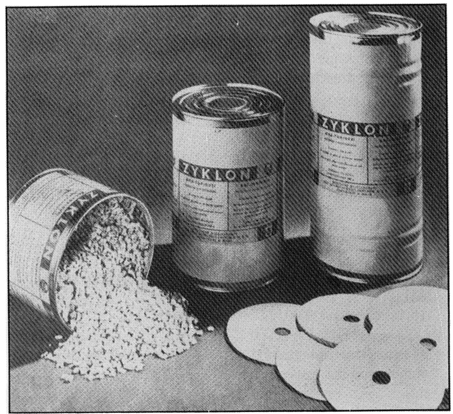
From the archives
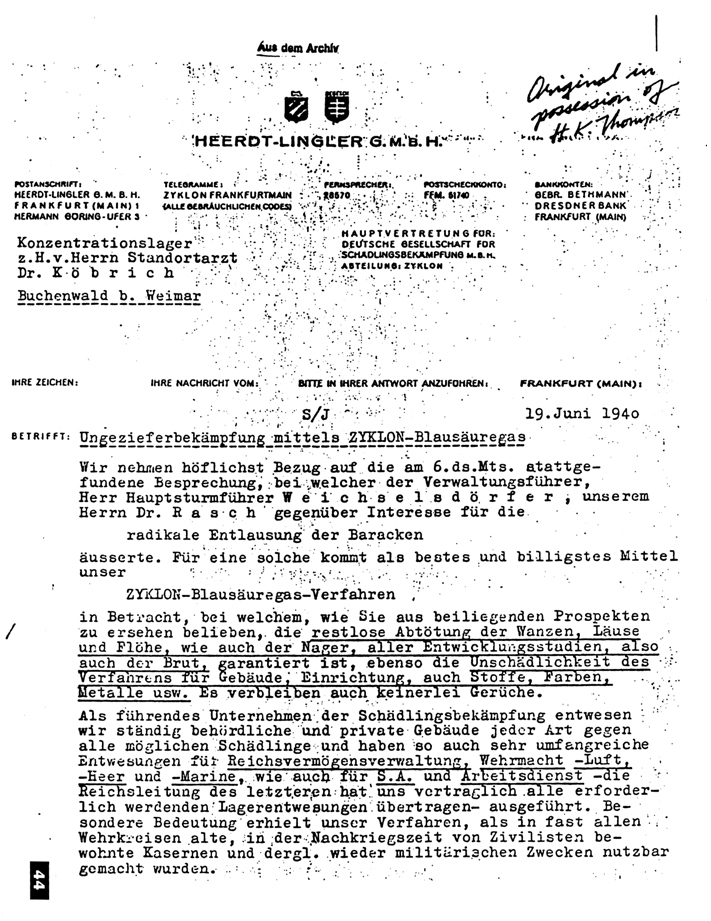
TRANSLATION OF DOCUMENT SHOWN ABOVE
HEERDT-LINGLER GMBH
Regarding: Vermin control by means of ZYLKON hydrocyanic acid gas.
With reference to the conversation on the 6th of this month, in which the administrative director, Hauptsturmführer Weichselsdörfer, expressed an interest in the radical delousing of barracks in speaking to Dr. Rachs of our firm.
The best and cheapest means of achieving such a purpose is our ZYKLON hydrocyanic acid gas process, which, as may be seen from the enclosed prospectus, guarantees the complete elimination of bedbugs, lice and fleas as well as all rodents in all stages of development as well as their young without damage to the building, installation, materials, dyes, metals, etc…. during the procedure. There are no residual odors.
As the leading company in vermin control, we are engaged in the constant disinfestations of public and private buildings of all kinds against all possible kinds of vermin. We have carried out disinfestations operations for Reichs administration offices, the Wehrmacht, Air Force, Army and Navy as well as all disinfestations operations which may prove necessary in the (labor service) camps. Our process is of particular significance when old barracks and buildings, inhabited by civilians during the post-war period, must again be converted for military purposes.
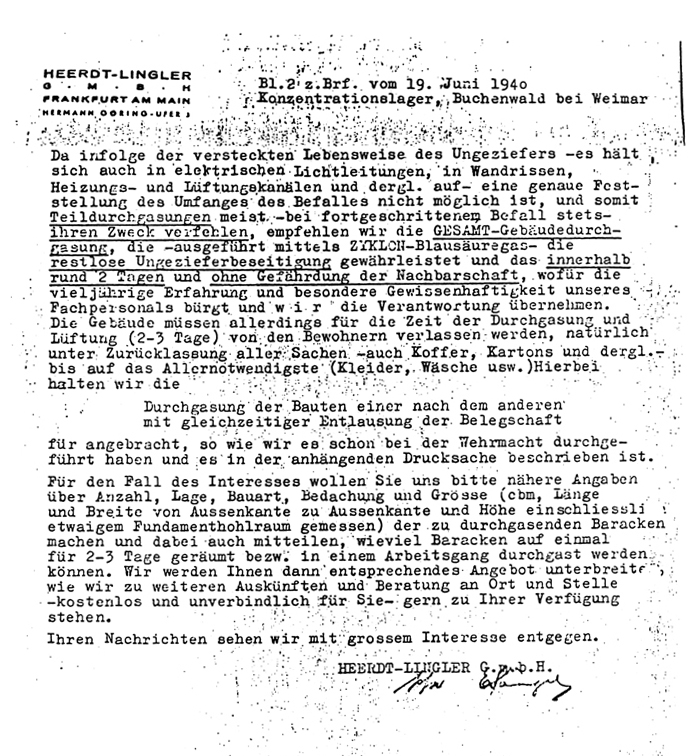
CONTINUATION OF TRANSLATION
In view of the fact that an, exact determination of the extent of infestation is impossible due to the concealed life cycle of the vermin, which clings to electrical wiring, cracks in the walls, heating and ventilation conduits and the like and since partial gassings always fail in their purpose due to continued infestation, we recommend TOTAL gassing of the building which, carried out using ZYKLON B hydrocyanic acid gas, guarantees total elimination of all vermin within two days, without endangering adjacent areas. We offer many years of experience and guarantee the particular conscientiousness of our expert personnel. We assume full responsibility. The buildings must, however, be vacated all personal belongings behind, such as suitcases, cartons and so forth, including the most essential items. For this purpose, we advise the complete gassing of all buildings, one after the other, with simultaneous delousing of all personnel. This has been our procedure with the Wehrmacht, as described in the enclosed printed material.
In the event that you are interested, please provide us with more exact information as to be number location, type of construction, roofing and dimensions (cubic meters, length and breadth, from outside corner to outside corner and height, including, for example, the measurement of any basement cavities) of the barracks to be disinfested. In addition, please advise us as to how many barracks must be vacated and totally gassed for 2 – 3 days at the same time in one single working process. We will be pleased to send you a corresponding price offer. We remain gladly at your disposal for any further information and advice on the spot, without cost or obligation to you.
We wait your reply with interest.
HEERDT – LINGLER GMBH
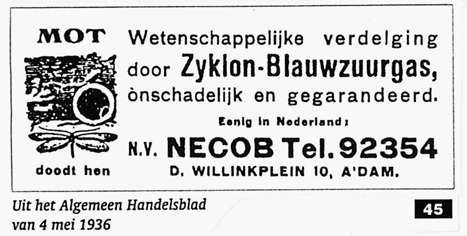
(45) Translation of advertisement shown above:
"Scientific pest extermination with Zyklon B hydrocyanic acid – harmless and guaranteed. Kills pests", etc..
The utilisation of Zyklon was hazardous. Trained personnel – mostly sanitation workers – using special gas masks (48)
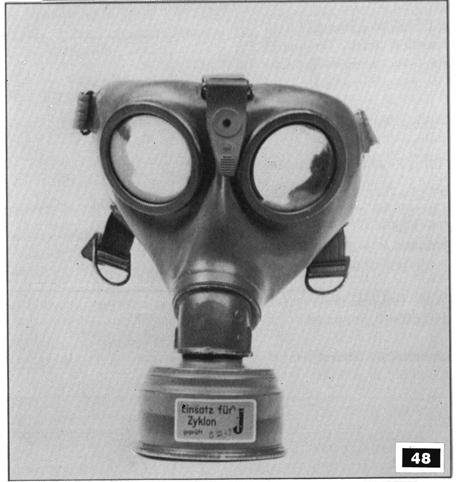
and a special can-opening device (49)
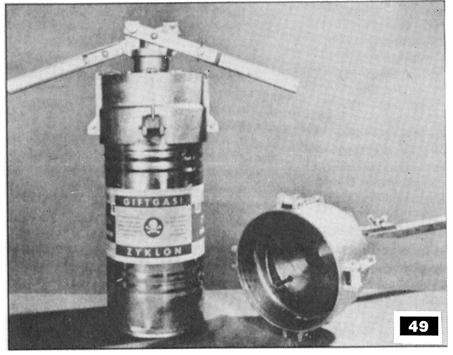
were assigned the job of fumigating, barracks and objects.
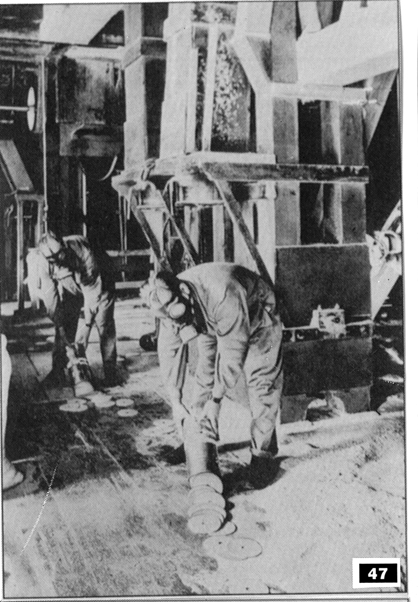
Specially-designed buildings and installations were also used for the purpose, using, in addition to HCN, hot air or steam. The latter was used chiefly for the delousing of clothing, blankets and mattresses, since this not only destroyed the vermin, but cleaned the material. This had the added advantage that it involved no risk, in contrast to the handling of Zyklon B, which was dangerous.

Zyklon B was initially used in the ‘disinfestations’ gas chambers located in structures BW5A and B (women’s camp), in addition to hot air and steam.
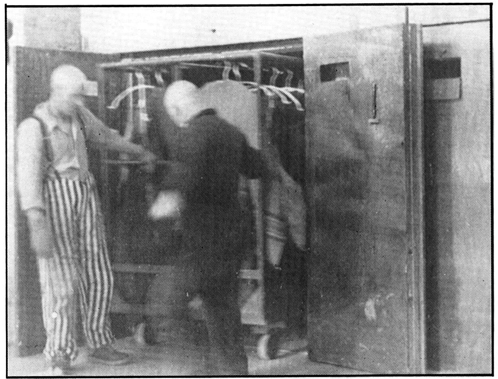
(51) Hot air disinfestations chamber in the central sauna at Birkenau. The claim was later made that the peepholes were proof of the existence of an execution gas chamber. That this is not the case, was later admitted by J.C. Pressac.
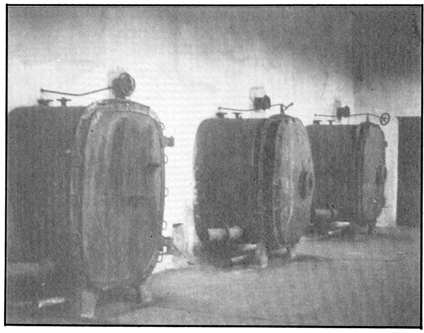
(52) The disinfestations installation at Birkenau (hot air system).
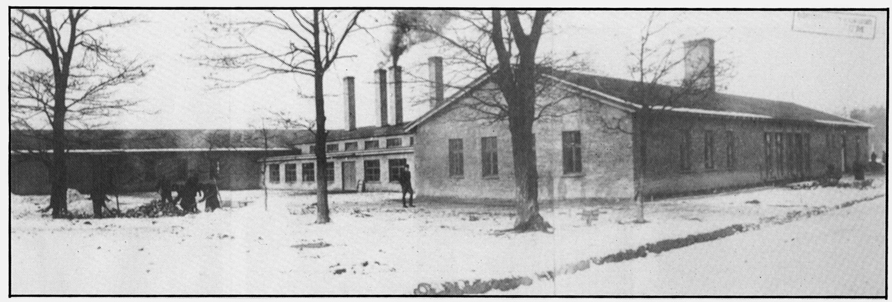
(53) The large sauna at Birkenau. The inmates entered these from the ‘unclean side’ (left wing of the building in the middle, with the smokestack).
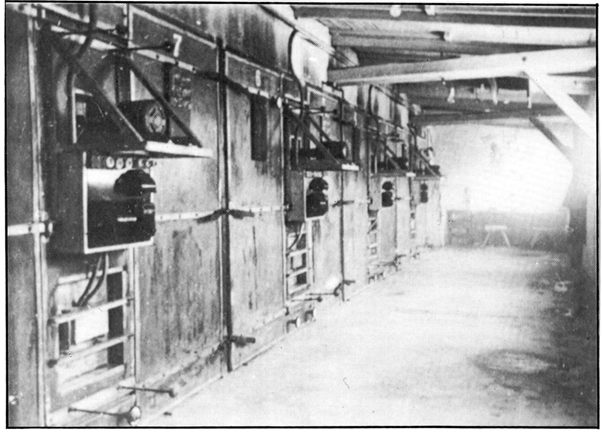
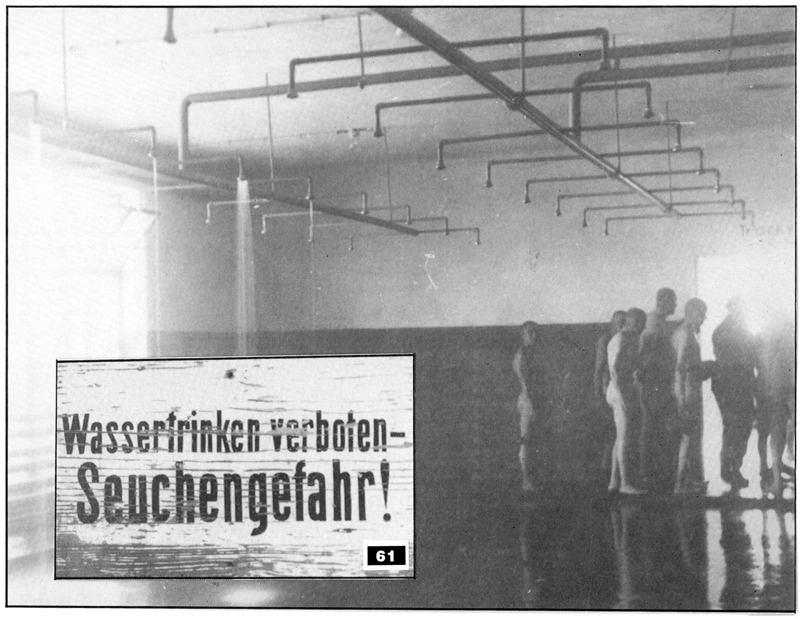
They received a haircut, then entered a shower building (62) (the building to the central wing). In the meantime, their clothing was disinfected (in the building in the middle with the four smokestacks). The inmates finally left the building on the other side – the ‘clean side’. All areas inside the building were equipped with central heating (later removed,
with or without evil intent), all work was done by the inmates themselves.

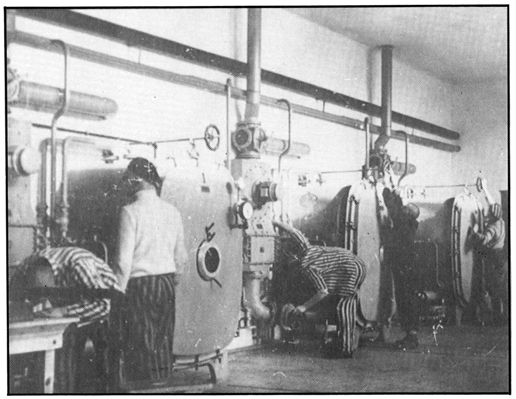
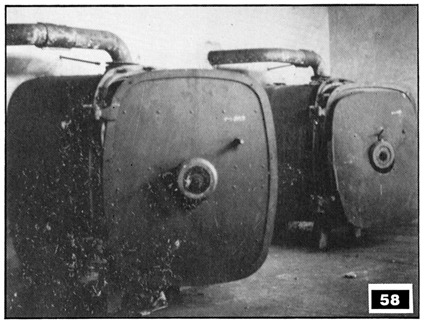
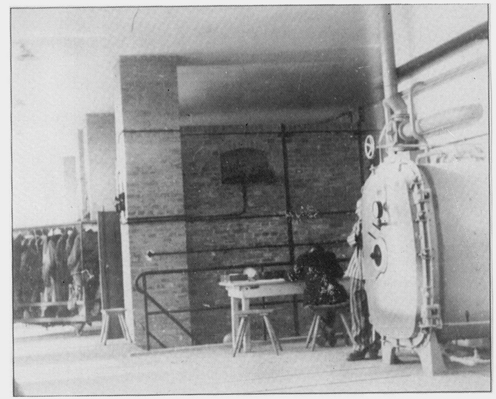
(52, 57, 58, 59) Autoclaves (‘unclean side’), arranged in the central sauna, where parasites, micro-organisms and carriers of epidemics disease in clothing, etc, were destroyed by steam under pressure (not a method of complete sterilization).
Note the massive doors which can be hermetically sealed, in gross contrast to the primitive wooden doors in the alleged gas chambers (88 – 92).
Why weren’t the ‘gas chambers’ also equipped with doors like this?
Apart from these autoclaves, there were another three disinfestations chambers operating with hot air in the central sauna.
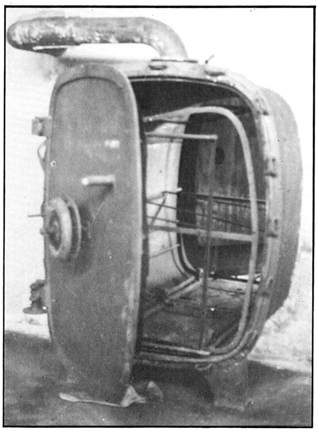
(55) One of the three autoclaves close-up. Note the adjustable rack which can be pulled in and out to hold the clothing.

(57) Inmates at work at the hot air delousing chambers in the Birkenau central sauna. These installations prove that the Germans were concerned with the health of their prisoners; who were needed for their labour.
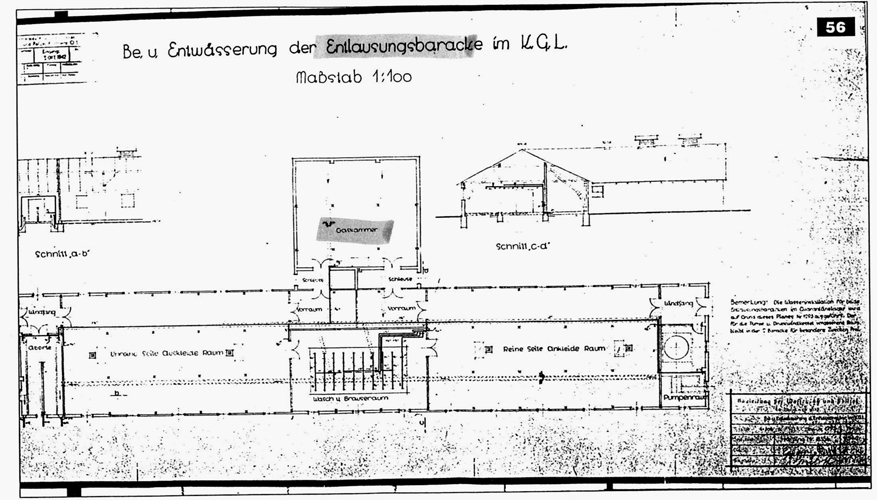
(56) The German word ‘Gaskammer’ often appears in German documents. This word refers to an area in which objects were disinfected with Zyklon B (a ‘normal gas chamber’) or another gas such as Ventox (‘special gas chamber’). Note the designation in the upper part of this diagram of the delousing barracks in BI (women’s section) at Birkenau.
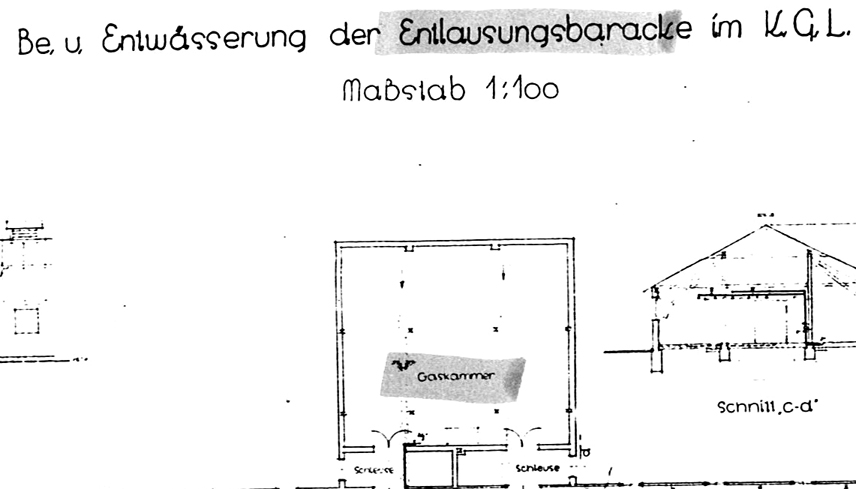
PARTIAL TRANSLATION OF DETAIL OF DOCUMENT SHOWN ABOVE:
Water supply and drainage of Delousing Barracks in Prisoner of War Camp
Scale: 1:100
Gas Chamber
[i.e., disinfestation chamber]
Air-tight lock Air-tight lock
The Auschwitz lie changed the gas chamber from a delousing installation, built to protect inmates from epidemics, into a gas chamber for the mass murder of undesired persons!
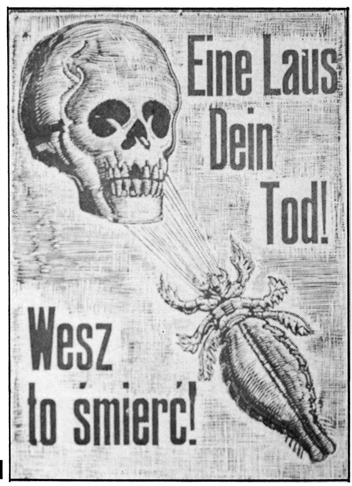
(60) Warning sign in Auschwitz. "One Louse = Your Death"
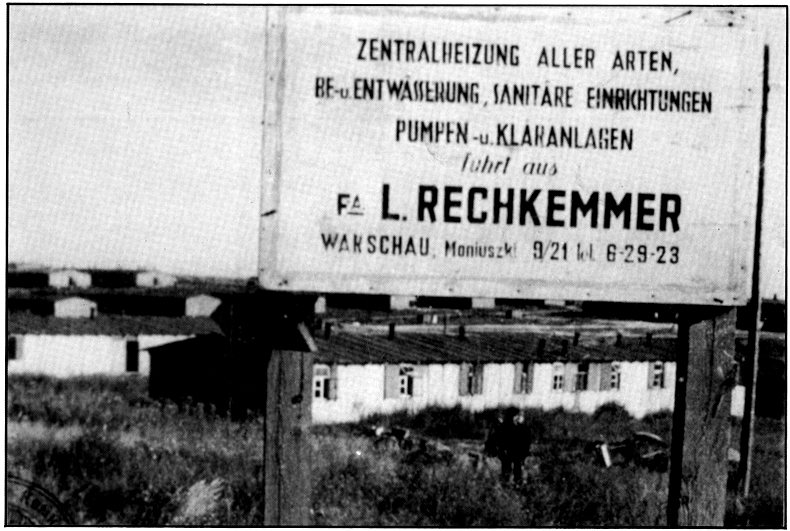
(63)
Sign advertising the role of civilian building firm at Majdanek camp. The thousands of civilian workers who came into daily contact with the inmates never made any reports about execution gas chambers.
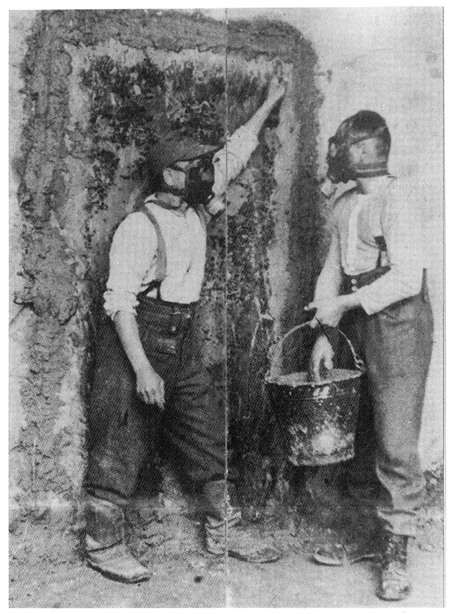
(64) The Soviets demonstrating how the Germans, supposedly gifted with normal human intelligence, allegedly proceeded during the mass gassings. The editor of the ‘Vim Nederland’ of 29 June 1991 comments. “The liberation of Madjanek camp in the summer of 1944. Russian soldiers showing how the cracks in the door of the gas chamber were sealed with mud and slime, to prevent the seepage of Zyklon B”.
“Vrij Nederland” published this rubbish in 1991 as ‘proof’ of mass gassings and sober- minded Dutch people swallow it without objection.
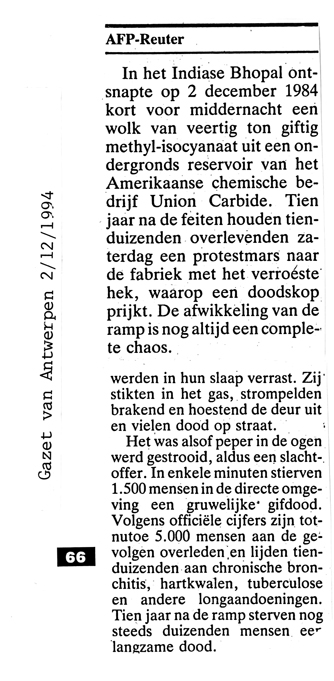
(65) At Bhopal (India) on 2 December 1984, just before midnight, a cloud of 40 tons of methyl isocyanides escaped from an underground tank at the American Union Carbide plant (…) The victims were asphyxiated in their sleep, fled outside vomiting and fell dead in the street. “It was as if someone had thrown pepper in their eyes”, said one survivor. 1500 Persons died miserably in a few minutes.
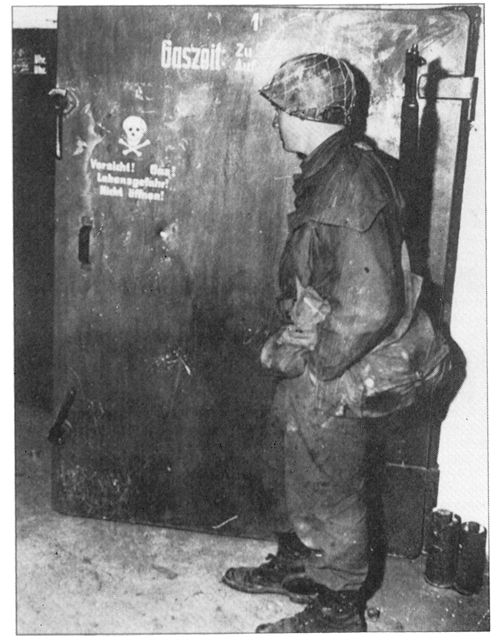
(67) This photo was reproduced for years to spread the gas chamber swindle. We are supposed to believe that the Germans did their best to fool their victims through the installation of shower heads, while the entry door to the gas chamber was marked with gassing times! For this reason the photo was later retouched to get rid of the inscription.
(67) After the war, the disinfestations chamber at Dachau was described as a gas chamber for the mass murder of prisoners! The gas chamber at Dachau was ‘disguised as a shower bath with false shower heads’, but the stupid Germans obviously forgot to remove the warning notice on the door: ‘Warning! Gas! Danger of dead! Do not open!’ together with the notice stating the gassing times.
Even the Americans eventually grasped the stupidity of this ‘proof’ and retouched the photo so as to delete the text of the warning from later photos.
- COULD THE GERMANS CONSTRUCT HUGE EXECUTION GAS CHAMBERS?
The following photos show that the Germans were able to build gigantic gas chambers and even that they were already available. This technology was therefore nothing new for them.
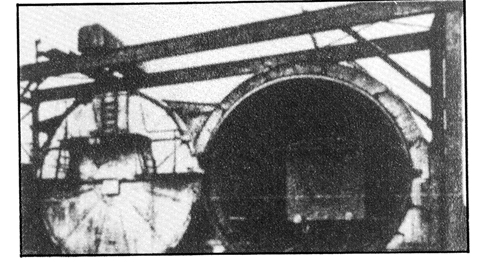
(68) Tunnel with open door. Note the train carriage. The door, which could be hermetically sealed, hung from a drawbridge and was placed before the entrance to the tunnel by means of an electrical motor.
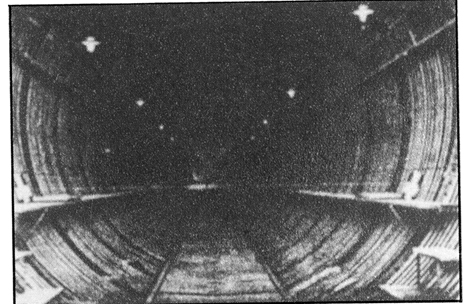
(69) This show the interior of a tunnel-shaped gas chamber equipped with rails, with enough space for several train carriages.
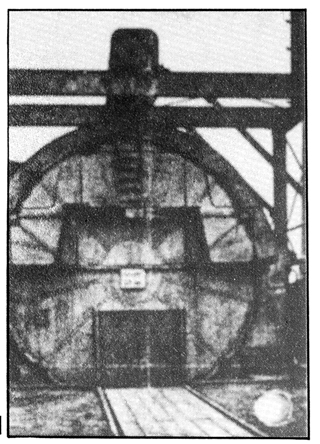
(70) Tunnel with door closed.
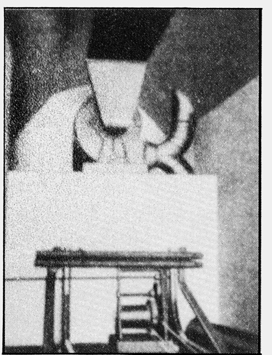
(71) Background of a tunnel installation in Budapest. Note the apparatus to bring the gas into circulation and exhaust it after the gassing operation.
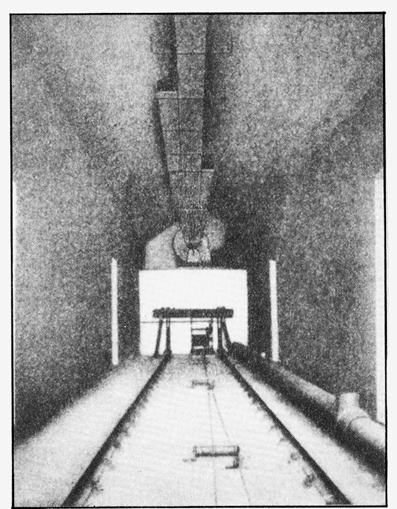
Interior
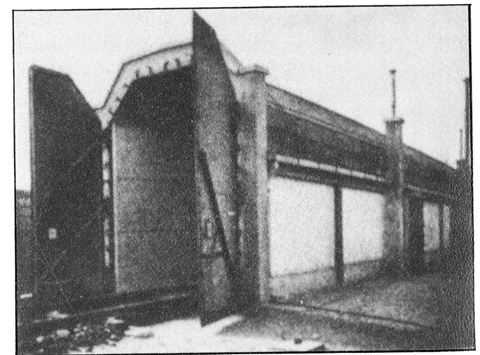
(73) This tunnel was located in Budapest. Note the exhaust pipes in the background. The claim is made that the Germans deported nearly 450,000
Hungarian Jews to Auschwitz in 1944 and gassed approximately 350,000 of them immediately after arrival. The question arises: why didn’t they gas them on the spot, right there in Budapest?
GAS CHAMBER TECHNOLOGY
The photos reproduced here originate from the various Leuchter reports. Fred Leuchter Jr. is an American gas chamber specialist who has written reports on several of the alleged gas chambers in German concentration camps.
An execution gas chamber is a small room, with chairs for one or two condemned prisoners and which must fulfill various criteria.
First, the gas chamber must be welded and pressure-proof. It must be coated with an inert coat of paint, stainless steel or plastic. The doors must be sealed with an HCN-resistant material. Windows, door and all hinges must be rendered gas-tight and sealed with rubber or tar-coated canvas and moreover sealed with neoprene or tar.
Second, the room must be entirely dry and equipped with a gas generator or distribution system to enable the circulation of the warm air-gas mixture. The mixture required for a gassing amounts to 3200 parts per million or 3.2% HCN. The chamber must be free of any obstacles and enable a strong, constant and rich flow of air.
Third, the gas chamber must be equipped with a device to exhaust and neutralize the air-gas mixture and replace it with fresh air.
This is assured by an exhaust blower or suction fan with an outlet and inlet valve with openings of sufficient size to permit a suitable exchange of air per hour. This requires at least one complete air exchange every 30 minutes; the room may entered only after two hours of ventilation at the earliest. Finally, the gas ejected after neutralization by means of a special device. The final exhaustion must take place through a long pipe.
The temperature inside the installation, as well as the air in the intake valve, must be least 10 degrees above the boiling point of hydro cyanide acid (26.3 degrees) to prevent condensation of the gas on the walls and floor. HCN has a tendency to crystallize and adhere to surfaces.
After use, the gassing installation must be detoxified ‘through an ammonia spray’. The personnel is required to wear special gas masks as well as protective clothing.
For further information, see the Leuchter reports, published by ‘Vrij Historisch Onderzoek’, Antwerp.
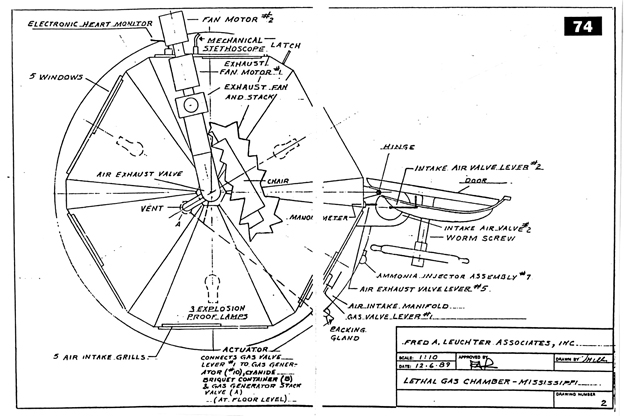
(74) The cabin seen from above, with the door open.
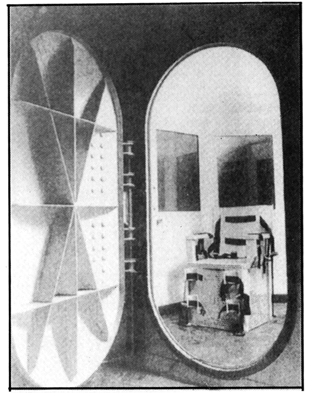
(75) View into the gas chamber at the penitentiary at St. Quentin, California. Note the heavy door.
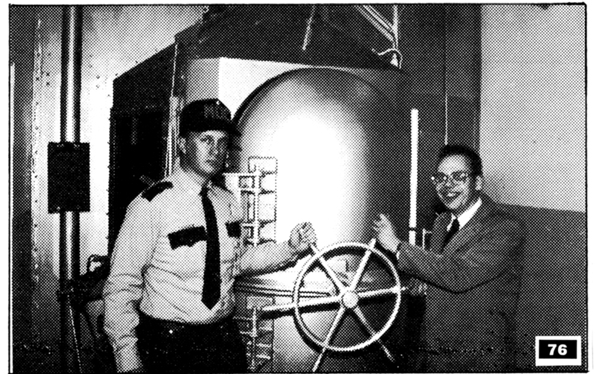
(76) Fred Leuchter Jr. (right) in front of the door to the execution gas chamber at Parchman, Mississippi. Leuchter was driven to commercial and professional ruin following the publication of his report.
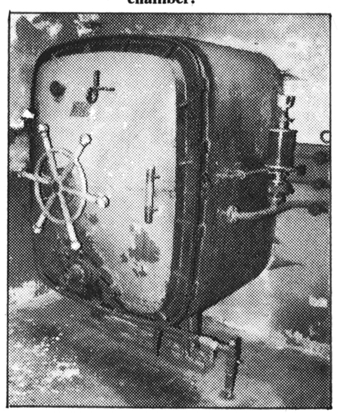
(77) Doors of a Zyklon B delousing chamber (in Auschwitz), exhibiting remarkable similarities to American gas chamber installations. And yet the Germans are supposed to have used primitive wooden doors in their so- called ‘real’ gas chambers, the gas chambers alleged to have been used for the mass murder of human beings!
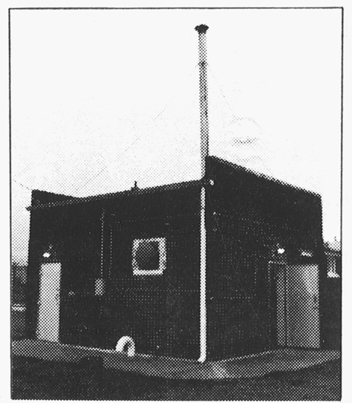
(78) The gas chamber at Parchman, Miss, seen from the outside. It is isolated from other buildings. Note the pipe for the exhaustion of the gas. There are no such pipes in the alleged German chambers, nor is there any trace or any such pipes.
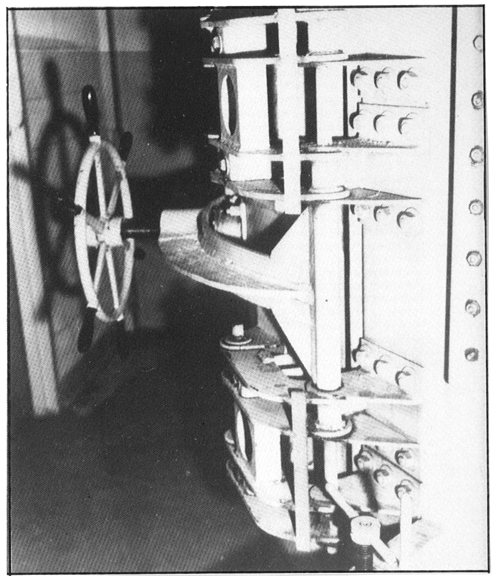
(78 and 79) The heavy entry door of an American execution gas chamber. Compare this with the alleged German gas chambers (88 – 92).
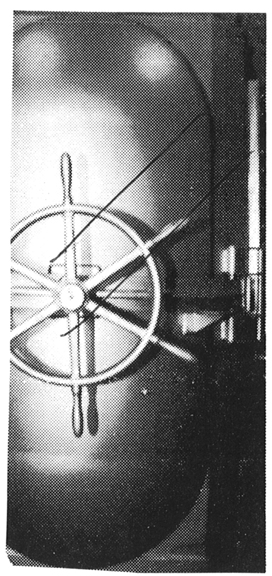
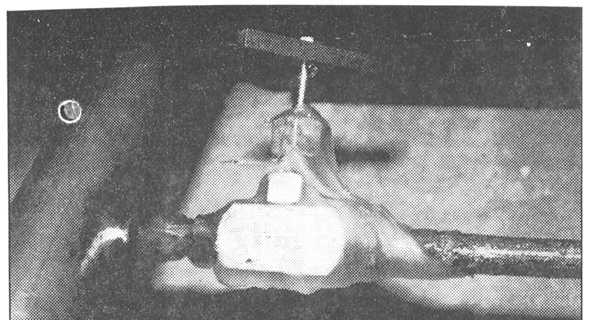
(81) All valves and connections are carefully welded and moreover coated with a sealant, in order to seal off leaks. There is no trace of anything similar in the ‘Nazi gas chambers’.
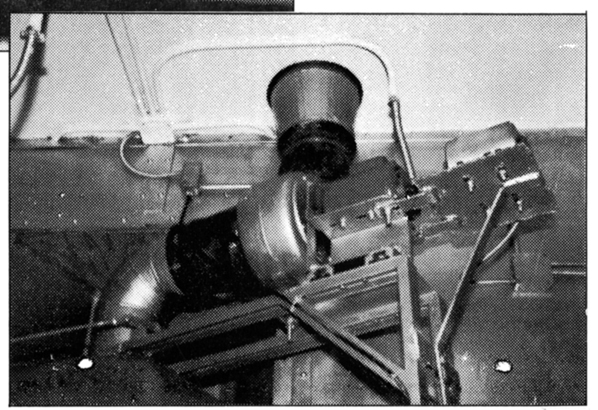
(82) The ceiling of the gas chamber. This is where the air-gas mixture exhausted from the gas chamber and expelled through the high chimney.
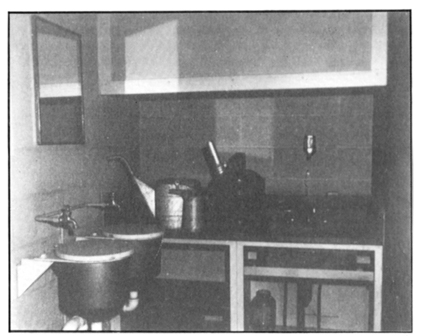
(83) This is where the chemicals are prepared.
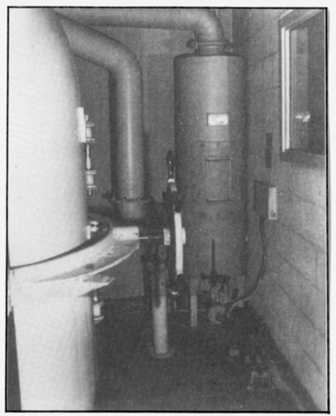
(84) Left: the heavy entry door. Right: the device to neutralize the air-gas mixture exhausted from the gas chamber and expelled through the high chimney.
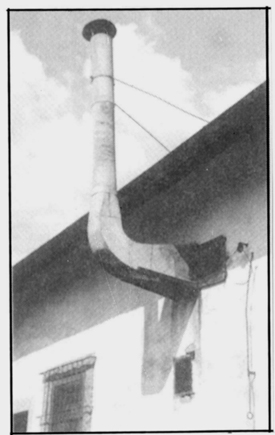
(86) The chimney of a German delousing chamber.
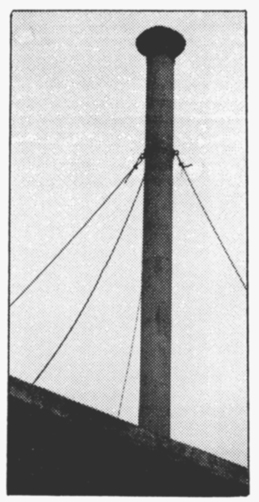
(87) The chimney of an execution gas chamber at Parchman, Mississippi.
GAS-TIGHT DOORS
Several German documents mention the delivery of ‘gas-tight doors’ to the crematoria. Jean-Claude Pressac’s Auschwitz. Technique and Operation of the Gas Chambers reproduces several of these documents.
Pressac believes that in so doing, he has provided proof for the criminal intent in the construction of the crematoria. In reality, however, these are quite ordinary doors or windows of finished wood, some of which may be seen in illustrations 88bis to 92. The only difference between these and a ‘non gas- tight’ door appears to be that a strip of felt has been nailed into the cracks of the ‘gas-tight’ doors.
The doors delivered to the Kremas were ‘gas-tight’, because, first of all, the temperature of a crematorium has to be kept down, secondly, to prevent the escape of odors and finally, because ventilation can only be effective if there are no counter-effective openings or poorly closed doors.
It should be obvious to anyone who has examined the doors of real execution gas chambers and delousing chambers, that these doors and windows could certainly never prevent the escape of a highly dangerous gas.
If the Germans had wished to use poison gas in these areas, they would have ordered and installed doors which were welded at the very least, such as those in the disinfestations chambers.
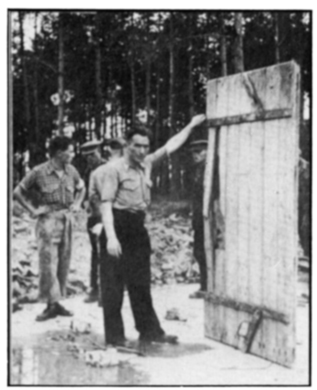
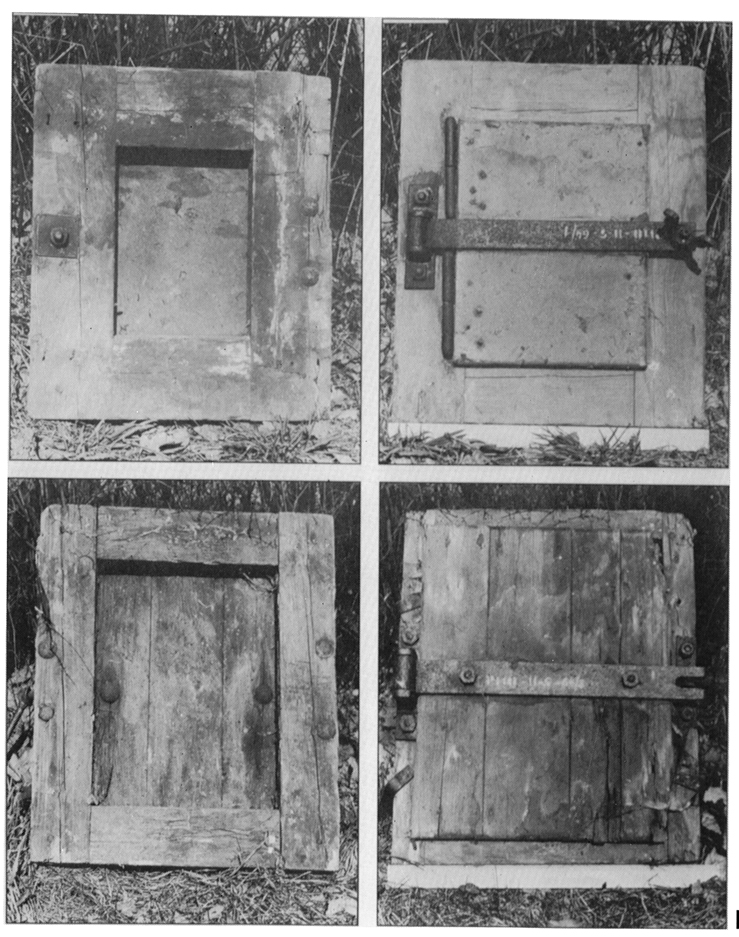
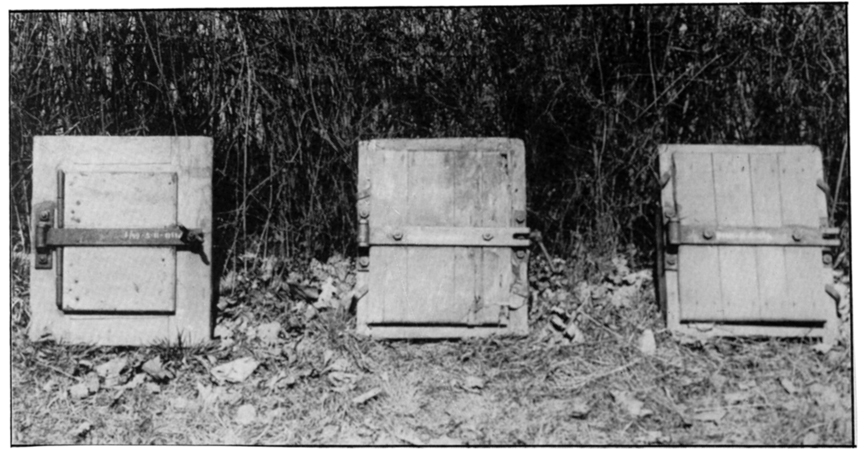
(88, 89 and 92) The legendary doors and hatches of the ‘gas chambers’ in which thousands of people are supposed to have been killed on a daily basis.
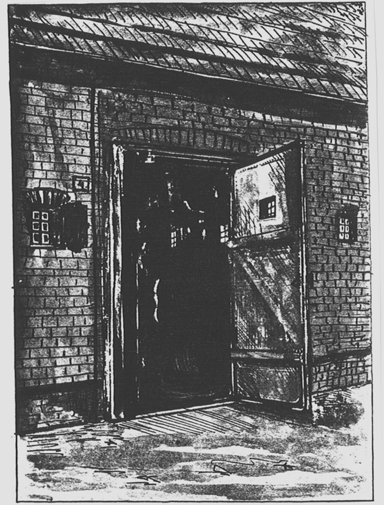
(90) This a drawing of the entrance door to the alleged gas chamber at Auschwitz, drawn by Auschwitz survivor Max Kantor.
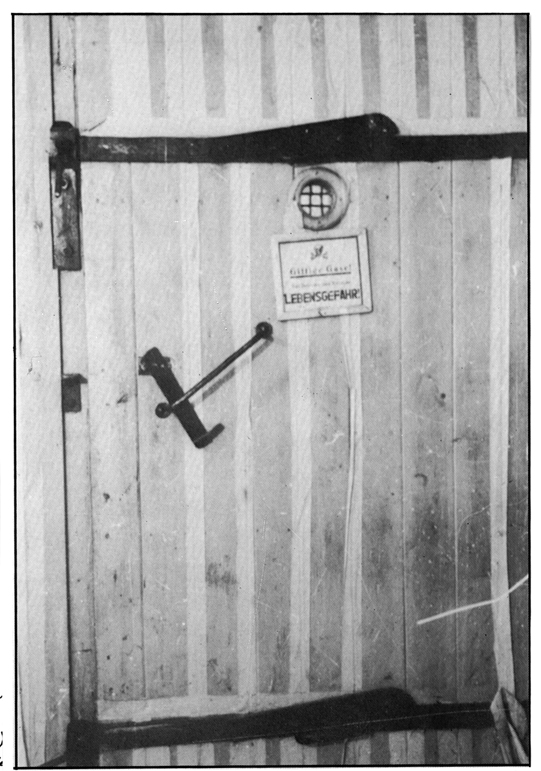
(91) Door to a disinfestations chamber with peephole. This is clear proof that the presence of such a peephole is not proof of the gassing of human being.
Chapter Three



























































